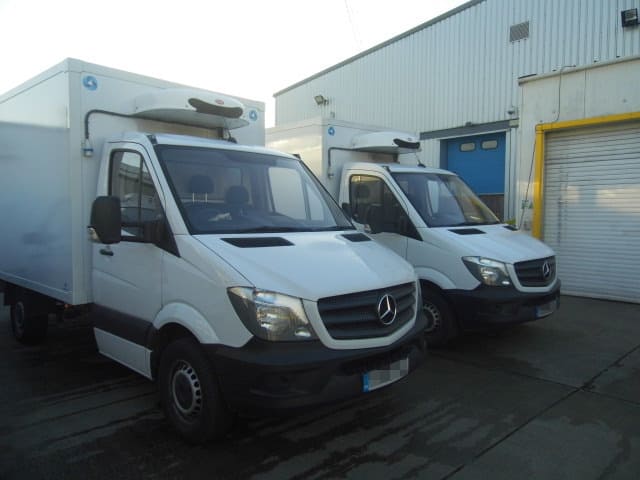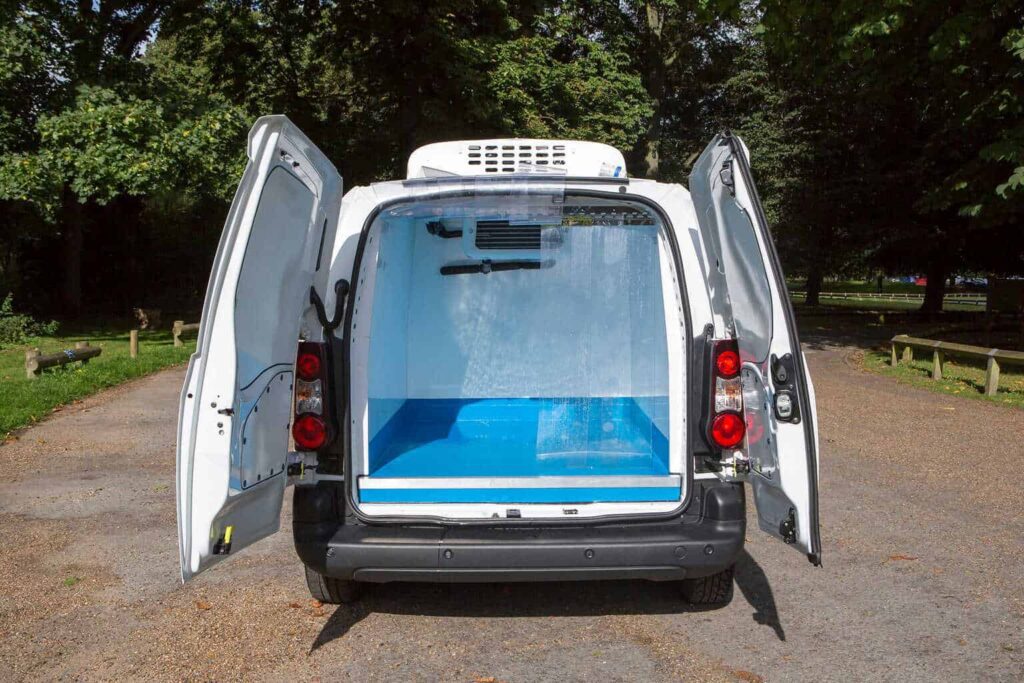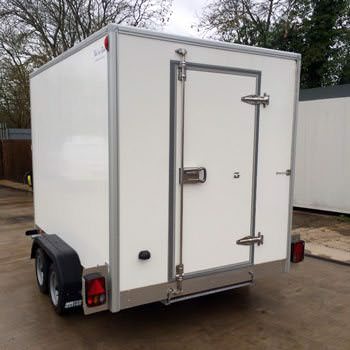When the British summer finally arrives, it often does so in a rush of short, intense heatwaves. Even a few days with temperatures nudging 30 °C can strain refrigerated vans and trailers that spend their lives loaded, idling in traffic or queuing at delivery bays.
Every extra degree outside makes your fridge engine, condenser fan and insulation work harder to keep the load space cold. Poorly prepared vehicles respond by cycling on and off, icing up or simply shutting down. The result can be spoiled food, rejected pharmaceutical consignments and damaged reputation.
1. Why Summer Is So Tough on Fridge Vans
Refrigeration is essentially the art of moving heat from inside the box to the air outside. In winter, the outside air might be 5 °C; in July it may be six times warmer.
The hotter the air, the harder the condenser has to work to dump heat, so the compressor inside the unit draws more current, heats up faster and reaches its safety limits sooner. Meanwhile drivers are opening doors more often because deliveries take longer in holiday traffic.
Warm moist air rushes in, clings to the evaporator plate and forms ice. If the system cannot defrost often enough, cold air flow is choked and the set-point drifts upwards.
Put simply: higher ambient heat + more door openings + extra ice equals double or triple the normal workload for your fridge plant, battery and fuel tank.
2. Common Problems You Will See – And What They Really Mean
Temperature drift is the easiest fault to notice. The dashboard controller still says –2 °C, but a quick probe of the cargo shows 1 °C or even 4 °C. Most of the time that gap is down to ice building up on the sensor or the evaporator face.
A manual defrost (often a two-button sequence) will melt the ice and drop the temperature back within thirty minutes. If the drift returns within an hour, suspect failing door seals or low refrigerant – both let warm air hang around the sensor.
High-pressure cut-out appears as an alarm code and the fridge stops. High pressure is almost always caused by a blocked condenser. Think of the condenser as a car radiator: clogged fins trap hot air.
A soft brush and a quick blast of low-pressure water flushed from the inside out will restore airflow. Parking the van so that the prevailing breeze blows through the condenser grille is a free extra fan.
Rapid clutch cycling (a loud click every few seconds under the bonnet) means the compressor cannot stay on. Often the refrigerant level is low because of a small leak, or the alternator voltage has dropped below 13.5 V because the battery is tired. Look for oily stains around hose joints and test the battery under load.
Puddles on the floor or fog in the box point to blocked drain holes. They are tiny and sit at the lowest point of the evaporator tray. A cable-tie or straw quickly poked through the hole lets melt-water escape before it drips onto parcels or refreezes into a lump of ice.
All of these faults can be tackled at the roadside if your drivers know what the alarms mean and carry a small emergency kit – spare fuses, a digital pocket thermometer, a head-torch and some tape for rigging a temporary doorway curtain.
3. The Spring “Hot-Weather Service”
Spending half a day on a dedicated summer service each April is far cheaper than one emergency call-out in July. Here is what a good workshop should cover – written in everyday language rather than engineer shorthand.
- Pressure and leak test: The technician connects two gauges to see if system pressures match what the fridge maker lists for a mild 20 °C day. Too low means gas is escaping; too high means the condenser is blocked.
- Deep clean of condenser: Fins are brushed straight and sprayed with a coil cleaner that dissolves greasy road film. Clean metal sheds heat better.
- Electrical health check: Batteries are tested for cranking power (cold-crank amps). Alternators should show at least 14 V with the engine running, proving they can recharge the battery during stop-start work.
- Door seals and hinges: Technicians slide a thin torch behind the rubber seal; light bleeding through indicates compressed or torn sections that need replacing. Warm summer air enters through the same gaps.
- Insulation scan: A cheap handheld thermal camera highlights dark patches where insulation has water damage. Those patches become hotspots in summer.
- Controller calibration: The main set-point probe is checked against a certified reference thermometer at –5 °C and +5 °C to keep readings honest.
- Firmware update: Modern units have software just like a phone; newer versions often improve how they behave in extreme heat.
4. Good Driving Habits That Save the Cold Chain
Drivers can make or break summer performance. A fifteen-minute briefing at the start of the season is enough.
- Pre-cool the load space. Run the fridge to the target temperature for at least half an hour before loading. Otherwise, the walls themselves are warm and will heat the first few cages.
- Load in drop order. Items for the last stop are placed at the front so the doors can stay shut longer.
- Keep door openings short. Attach a buzzer that sounds after 60 seconds, reminding the driver to close. Strip curtains fitted just inside the door trap most of the warm air that rushes in.
- Fuel awareness. Most diesel fridge engines cut out when the vehicle’s tank falls below 15%. Drivers should top up at one quarter, not when the warning light appears.
- Daily walk-around. Feel for a steady blast of warm air out of the condenser grille (that shows the fan is working). Listen for odd rattles. Cross-check the controller temperature against an independent probe. A small difference early in the day is a clue before anything spoils.
5. Stocking a Low-Cost “Summer Survival” Kit
You can fit everything you need under the passenger seat:
- A handful of the large 40 A and 60 A blade fuses used by most standby and alternator circuits.
- A three-metre clear plastic sheet and masking tape to create an instant doorway barrier if the curtain is torn.
- A digital probe thermometer with spare batteries to confirm cargo temperatures.
- A small aerosol of condenser coil cleaner and a soft brush.
- A head-torch so faults can be spotted inside dark depots.
- A compact 12 V jump-pack to start a lazy diesel fridge motor or boost the battery.
- Disposable gloves and sanitising wipes for hygienic probe handling.
The entire kit costs less than one pallet of melted ice-cream.
6. Simple Upgrades That Make Big Differences
If you run high-value, temperature-sensitive loads—or you know your routes involve long waits at docks or music festivals—consider a few extras:
- High-ambient condenser kits add larger fans or deeper fins so the unit can still reject heat when the outside air is 40 °C.
- Solar trickle chargers fix onto the roof and top up the fridge battery whenever the sun is out, counteracting drain from telematics and interior lights during breaks.
- Remote temperature monitoring sends readings over 4G every five minutes and texts a duty manager the moment the box climbs out of range.
- Automatic door closers work like kitchen cupboard dampers—drivers step out, doors glide shut on their own.
- LED lighting inside the load space produces much less heat than old fluorescent tubes, so the fridge does not have to remove unnecessary warmth.
FridgeXpress can supply hire vans and trailers with any of these fitted from day one, avoiding capital outlay on equipment you may only need for three summer months.
7. Keeping the Paperwork (and Inspectors) Happy
UK Food Hygiene Regulations, and the Medicines and Healthcare products Regulatory Agency for pharmaceuticals, demand proof that temperature has been controlled. In summer that proof is more heavily scrutinised. Make sure you:
- Use an automatic data-logger or telematics platform that saves readings to the cloud, not a paper chart that fades in the glove box.
- Keep file servicing and calibration certificates, where auditors can see them.
- Note any alarm, the action taken and the cargo temperature you recorded afterwards. That “corrective action” line often stops a minor blip from becoming a fine.
- Dip-test your pocket thermometers in a crushed-ice bath once a month and write down the result. Inspectors increasingly ask for that log.
- Keep generator run-hour totals; some insurers require that engines be overhauled at fixed intervals.
When your paperwork is in order, most enforcement visits finish with a handshake rather than a notice.
The Value of a Relationship with FridgeXpress
FridgeXpress is not just a rental desk. We live and breathe temperature control, so our fleet is prepared for the worst of the British summer before it ever reaches your site.
If you need to build a relationship with a supplier of refrigerated vehicles, FridgeXpress offers a high level of expertise, an amazing choice of vans and trailers and flexible hire options that include regular servicing.




